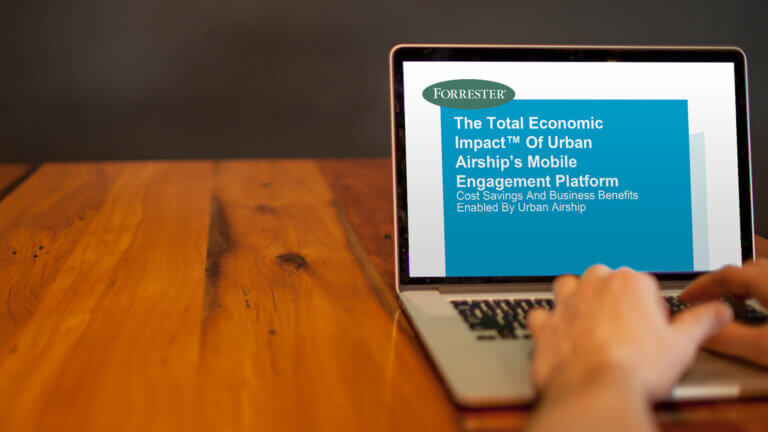
Why Mobile Engagement Should Be at the Center of Your Mobile App Strategy

AJ Park Sr. Content Marketing Manager
What Is Mobile Engagement?
Mobile engagement is the act of engaging a user through available messaging channels inside and outside of an app. Companies use mobile engagement to deliver positive brand experiences, support their business goals and build valuable, long-term relationships.
Engagement typically starts the moment a user downloads your app. Showing users your app’s value from the very beginning is essential to building a long-term relationship that keeps them coming back.
But it can’t stop there. Ongoing engagement with your app users is the ticket to keeping them. Through an exhaustive data study of over 3,000 apps, we’ve found that push notifications, just one capability of our mobile engagement solution, doubles user retention.
We wanted to discuss what constitutes quality mobile engagement, and when and how a brand should reach out to customers. We’ll also cover the diverse revenue benefits that can come from cultivating a loyal app audience.
Why Should You Care?
Why is mobile engagement such a big deal for brands? Mobile is where your customers are spending most of their time. A study published by Compuware says that more than 80% of customers prefer mobile apps to traditional websites. According to Flurry Insights, mobile has officially surpassed the television as the favorite screen.
With more than three million apps in the Apple App Store and Google Play Store, consumers have unprecedented options in the world of mobile apps.
Brands are actively trying to increase their subscriber base through ads, and the ad market is responding. In fact, the price for promoting apps is escalating.
Most brands are still using a “download-only” approach — simply trying to get users to download their app — and considering that to be meaningful. But what is the real value of a download? According to The Good Push Index, Urban Airship’s landmark study on push notifications, 70% of an app’s users will defect after 30 days if the brand does nothing to engage with them.
Citing download numbers as a mark of your app’s success is like tracking impressions on a website instead of other, more meaningful business outcomes. App downloads are a vanity metric.
Your app must stand out from the moment it is downloaded, otherwise, it will be promptly forgotten (or worse, deleted). The answer to this problem is to grab the attention of your app audience through mobile engagement from the very beginning.
The Power of Mobile Engagement Demonstrated
A great example of the power of mobile engagement can be found by looking at Redbox, a popular automated rental retailer of new-release movies and video games. With the Redbox app (iOS; Android), users can browse options, find the nearest kiosks and reserve their selections for pickup. Proof of the power of mobile engagement lies in the very first push notification Redbox sent, which drove 16X more online traffic than its busiest web traffic day ever.
Through Urban Airship, Redbox uses push notifications and in-app welcome messages to educate and onboard new users as soon as they download the app. The first push notification in this series delivers a free rental code within an hour after the app is first opened, which drives users to register and seek out their nearest kiosk.
Quality mobile engagement should empower a customer to engage with a brand at their exact moment of inspiration. This can mean informing a user’s future purchase, or simply delivering customer service right when they need it.
With Great Power Comes Great Responsibility
As a new medium, mobile provides unique capabilities. The personal, always-on nature of mobile allows marketers to reach their customers and brand advocates anywhere, anytime. It’s a privilege to reach a person in such a direct and intimate way, and if brands abuse this privilege, the consequence will be felt when a user uninstalls their app.
Fueled by Mobile
Although the majority (by a small margin) of digital transactions still occur outside of mobile apps, many crucial pre-shopping interactions are taking place via mobile. According to Deloitte Digital’s “Navigating the Digital Divide,” 64% of in-store retail sales are expected to be digitally influenced by the end of 2015.
Additionally, InternetRetailer.com found that nearly half of digital shoppers at the top ten retailers are now mobile-only, which is especially impressive considering how recently mobile shopping became available.
Moving From Good Push to Great Engagement
Whether it’s fueling conversions and transactions, providing relevant utility, or deepening customer relationships, there are many different ways to engage with your customers — inside and outside your app. By fostering a connection with your customers via mobile engagement, your app — and brand — will succeed and charge ahead of its competitors.
As leaders in the mobile engagement movement, we want to help you move from good push to great engagement. For more insights on mobile marketing strategy and content that can make it easier to do your job, explore our Content Library or contact us.
Subscribe for updates
If the form doesn't render correctly, kindly disable the ad blocker on your browser and refresh the page.
Related Posts

